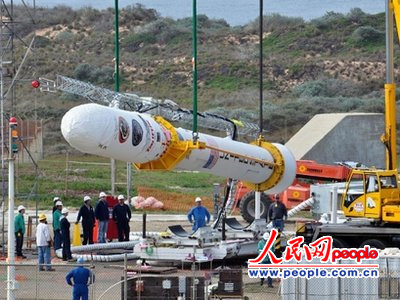US earth-observation satellite crashes into Pacific Ocean
NASA's earth-observation satellite Glory apparently fell into the Pacific Ocean after a failed launch, a NASA official said early Friday.
 |
|
NASA's earth-observation satellite Glory apparently fell into the Pacific Ocean after a failed launch, a NASA official said on March 4, 2011. [People.com.cn] |
"All indications are that the satellite and rocket are in the southern Pacific Ocean somewhere," NASA launch director Omar Baez said at a news conference after the mishap.
NASA said in a statement that the rocket's first three solid-fuel stages ignited as planned, but the protective shell atop the rocket, which lifted off about 2:10 a.m. PST (1010 GMT) from Vandenberg Air Force Base, did not separate as expected about three minutes after launch.
"We are at T+plus 300 seconds," Richard Haenke, the ascent commentator, reported. "The vehicle speed error is indicating underperformance, which is expected due to a fairing not separating. We have a report the system did pressurize. However, we still have no indication of the fairing separating."
That left the Glory spacecraft without the velocity to reach orbit, NASA launch commentator George Diller said.
"The flight was going well until the time of fairing separation," Diller said, "We did not have a successful fairing separation from the Taurus and there was insufficient velocity with the fairing still on for the vehicle to achieve orbit."
A few moments later, Baez declared a failure.
"We have had a contingency on the Glory mission," he told the launch team. "Please enact the mission mishap preparedness and contingency plan. Begin with notification, data impoundment and mishap response tasks...Do not attempt to call out and release information to anyone or speculate on the cause of the contingency."
Glory was launched on a three-year mission to collect data that scientists planned to use to better understand how the sun and tiny atmospheric particles called aerosols affect the Earth's climate. Besides monitoring particles in the atmosphere, it will also track solar radiation to determine the sun's effect on climate change.
The 424 million U.S. dollar mission is managed by the NASA's Goddard Space Flight Center in Maryland. Orbital Sciences Corp. of Dulles, Virginia, is the launch service provider of the four-stage Taurus XL rocket and is also the builder of the Glory satellite for Goddard.
"It's a pretty tough time for all of us," an executive from Orbital Sciences told the press conference. "We have many professionals. We will recover. We will bounce back."
Although NASA has lost Glory mission, Michael Luther, NASA's deputy associate administrator for program, told the conference that the U.S. space agency will continue to launch "more than a dozen missions in the next 10 years" to contribute to the understanding of earth.
This was the second failure in a row for a Taurus XL rocket. NASA's 273-million-dollar Orbiting Carbon Observatory was lost in a launch failure on Feb. 24, 2009, when it suffered a similar nose cone fairing failure.
Orbital Sciences redesigned the system in the wake of that failure and it has flown successfully three times since then on the company's Minotaur rocket.
 0
0 







Go to Forum >>0 Comments